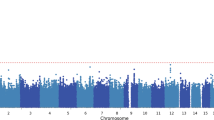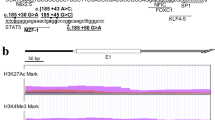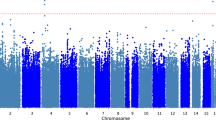Abstract
Tardive dyskinesia (TD) is an iatrogenic disorder observed in ∼20–30% of schizophrenia patients on long-term treatment with typical antipsychotic drugs. CYP1A2 is involved in the metabolism of atypical antipsychotic drugs such as clozapine and olanzapine. It is not directly involved in the metabolism of typical antipsychotic drugs, but gains importance when the schizophrenia patients are under long-term chronic treatment, acting as a low-affinity high-capacity metabolizing enzyme. In this study, we have completely sequenced the coding region to ascertain the presence of common coding polymorphisms and their role if any in susceptibility to TD and schizophrenia. Four previously reported polymorphisms, CYP1A2*1F (intron A), rs2472304 & rs3743484 (intron D) and rs2470890 (CYP1A2 1545 C>T) in exon 7 were identified. We further investigated whether the CYP1A2 1545 C>T polymorphism has any role to play in susceptibility to TD and in schizophrenia per se. Association of this single nucleotide polymorphism with TD (P=0.03) and schizophrenia (P=0.04) was observed, but was rendered insignificant after corrections for multiple comparisons.
This is a preview of subscription content, access via your institution
Access options
Subscribe to this journal
Receive 6 print issues and online access
$259.00 per year
only $43.17 per issue
Buy this article
- Purchase on Springer Link
- Instant access to full article PDF
Prices may be subject to local taxes which are calculated during checkout

Similar content being viewed by others
References
Yassa R, Ananth J . Familial tardive dyskinesia. Am J Psychiatry 1981; 138: 1618–1619.
Muller DJ, Schulze TG, Knapp M, Held T, Krauss H, Weber T et al. Familial occurrence of tardive dyskinesia. Acta Psychiatr Scand 2001; 104: 375–379.
Kane JM, Smith JM . Tardive Dyskinesia: prevalence and risk factors 1959 to 1979. Arch Gen Pscychiaty 1982; 39: 473–481.
Bergen J, Kitchin R, Berry G . Predictors of the course of tardive dyskinesia in patients receiving neuroleptics. Biol Psychiatry 1992; 32: 580–594.
Andreassen OA, Jorgensen HA . Neurotoxicity associated with neuroleptic-induced oral dyskinesias in rats. Implications for tardive dyskinesia? Prog Neurobiol 2000; 61: 525–541.
Lohr JB, Kuczenski R, Niculescu AB . Oxidative mechanisms and tardive dyskinesia. CNS Drugs 2003; 17: 47–62.
Casey DE . Pathophysiology of antipsychotic drug-induced movement disorders. J Clin Psychiatry 2004; 65 (Suppl 9): 25–28.
Basile VS, Masellis M, Potkin SG, Kennedy JL . Pharmacogenomics in schizophrenia: the quest for individualized therapy. Hum Mol Genet 2002; 11: 2517–2530.
Lerer B, Segman RH, Fangerau H, Daly AK, Basile VS, Cavallaro R et al. Pharmacogenetics of tardive dyskinesia: combined analysis of 780 patients supports association with dopamine D3 receptor gene Ser9Gly polymorphism. Neuropsychopharmacology 2002; 27: 105–118.
Shimada T, Yamazaki H, Mimura M, Inui Y, Gungerich FP . Interindividual variations in human liver cytochrome P450 enzymes involved in the oxidation of drugs, carcinogens and toxic chemicals: studies with liver microsomes of 30 Japanese and 30 Caucasians. J Pharmacol Ther 1994; 270: 414–423.
Basile VS, Ozdemir V, Masellis M, Walker ML, Meltzer HY, Lieberman JA et al. A functional polymorphism of the cytochrome P450 1A2(CYP1A2) gene: association with tardive dyskinesia in schizophrenia. Mol Psychiatry 2000; 5: 410–417.
Nakajima M, Yokoi T, Mizutani M, Kinoshita M, Funayama M, Kamakati T . Genetic polymorphism in the 5′ – flanking region of human CYP1A2 gene: effect on the CYP1A2 inducibility in humans. J Biochem 1999; 125: 803–808.
Sachse C, Brockmoller J, Bauer S, Roots I . Functional significance of a C>A polymorphism in intron I of the cytochrome P450 CYP1A2 gene tested with caffeine. Br J Clin Pharmacol 1999; 47: 445–449.
Tiwari AK, Deshpande SN, Rao AR, Bhatia T, Mukit SR, Shriharsh V et al. Genetic susceptibility to tardive dyskinesia in chronic schizophrenia subjects: I. Association of CYP1A2 gene polymorphism. Pharmacogenomics J 2005; 5: 60–69.
Ikeya K, Jaiswal AK, Owens RA, Jones JE, Nebert DW, Kimura S . Human CYP1A2: sequence, gene structure, comparison with mouse and rat orthologous gene, and differences in liver mRNA expression. Mol Endocrinol 1989; 3: 1399–1408.
Chevalier D, Cauffiez C, Allorge D, Lo-Guidice JM, Lhermitte M, Lafitte JJ et al. Five novel natural allelic variants – 951 A4C, 1042 G4A (D348N), 1156A4T (I386F), 1217 G4A (C406Y) and 1291 C4T (C4341Y) – of the mutation in a French Caucasian population. Hum Mutat 2001; 17: 355–360.
Dolder CR, Jeste DV . Incidence of tardive dyskinesia with typical versus atypical antipsychotics in very high risk patients. Biol Psychiatry 2003; 53: 1142–1145.
Ossowska K . Neuronal basis of neuroleptic-induced extrapyramidal side effects. Pol J Pharmacol 2002; 54: 299–312.
Prior TI, Baker GB . Interactions between the cytochrome P450 system and the second-generation antipsychotics. J Psychiatry Neurosci 2003; 28: 99–112.
Coon H, Jensen S, Holik J, Hoff M, Myles-Worsley M, Reimherr F et al. Genomic scan for genes predisposing to schizophrenia. Am J Med Genet 1994; 54: 59–71.
Freedman A, Coon H, Myles-Worsley M, Orr-Urtreger A, Olincy A, Davis A et al. Linkage of a neurophysiological deficit in schizophrenia to a chromosome 15 locus. Proc Natl Acad Sci USA 1997; 94: 587–592.
Kaufman CA, Suarez B, Malaspina D, Pepel J, Svarakic D, Meyer J et al. NIMH genetics initiative millenium schizophrenia consortium: linkage analysis of African American pedigrees. Am J Med Genet 1998; 88: 29–33.
Stober G, Saar K, Ruschendorf F, Meyer J, Nurnberg G, Jatzke S et al. Splitting schizophrenia: periodic catatonia-susceptibility locus on chromosome 15q15. Am J Hum Genet 2000; 67: 1201–1207.
Morse DC, Steim AP, Thomas PE, Lowndess HE . Distribution and induction of cytochrome P450 1A1 and 1A2 in rat brain. Toxicol Appl Pharmacol 1998; 152: 232–239.
Guy W ed. Early Clinical Drug Evaluation Unit b Assessment Manual. US Department of Health and Human Services, National Institute of Mental Health (NIMH): Rockville, MD, 1976.
Sham PC, Curtis D . Monte Carlo tests for associations between disease and alleles at highly polymorphic loci. Ann Hum Genet 1995; 59: 97–105.
Stephens M, Smith NJ, Donnelly P . A new statistical method for haplotype reconstruction from population data. Am J Hum Genet 2001; 68: 978–989.
Stephens M, Donnelly P . Comparison of bayesian methods for haplotype reconstruction from population genotype data. Am J Hum Genet 2003; 73: 1162–1169.
Acknowledgements
This work is supported by a Department of Biotechnology (Government of India) Grant BT/PR2425/Med 13/089/2001 (to BKT and SND); Indo-Israel Grants BT/IC-2/Israel/Deshpande/2002 and BT/IC-2/00/Smita/99 (to SND, BKT, BL); a grant from NIMH to VLN (MH5624) and a senior research fellowship from the University Grants Commission, New Delhi to AKT.
Author information
Authors and Affiliations
Corresponding author
Additional information
Duality of Interest
The authors declare that they have no competing financial interest.
Rights and permissions
About this article
Cite this article
Tiwari, A., Deshpande, S., Lerer, B. et al. Genetic susceptibility to Tardive Dyskinesia in chronic schizophrenia subjects: V. Association of CYP1A2 1545 C>T polymorphism. Pharmacogenomics J 7, 305–311 (2007). https://doi.org/10.1038/sj.tpj.6500415
Received:
Revised:
Accepted:
Published:
Issue Date:
DOI: https://doi.org/10.1038/sj.tpj.6500415
Keywords
This article is cited by
-
Significance of an altered lncRNA landscape in schizophrenia and cognition: clues from a case–control association study
European Archives of Psychiatry and Clinical Neuroscience (2023)
-
Influence of single-nucleotide polymorphisms on deferasirox Ctrough levels and effectiveness
The Pharmacogenomics Journal (2015)
-
CYP1A2polymorphism −1545C > T (rs2470890) is associated with increased side effects to clozapine
BMC Psychiatry (2014)
-
Support for association of HSPG2 with tardive dyskinesia in Caucasian populations
The Pharmacogenomics Journal (2012)
-
Cytochrome P450 testing for prescribing antipsychotics in adults with schizophrenia: systematic review and meta-analyses
The Pharmacogenomics Journal (2011)



